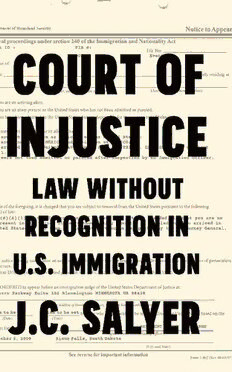
Court of Injustice: Law Without Recognition in U.S. Immigration PDF
Preview Court of Injustice: Law Without Recognition in U.S. Immigration
Court of Injustice This page intentionally left blank Court of Injustice Law Without Recognition in U.S. Immigration J.C. Salyer Stanford University Press Stanford, California Stanford University Press Stanford, California © 2020 by the Board of Trustees of the Leland Stanford Junior University. All rights reserved. No part of this book may be reproduced or transmitted in any form or by any means, electronic or mechanical, including photocopying and recording, or in any information storage or retrieval system without the prior written permission of Stanford University Press. Printed in the United States of America on acid-free, archival-quality paper Library of Congress Cataloging-in-Publication Data is available on request. ISBN: 978-1-5036-1140-5 (cloth) ISBN: 978-1-5036-1248-8 (paperback) ISBN: 978-1-5036-1249-5 (electronic) Cover design: Michel Vrana Typeset by Motto Publishing Services in 10/14 Minion Pro For Paige West This page intentionally left blank Contents Acknowledgments ix Introduction: Th e Paradoxes of U.S. Immigration Law and Deportation 1 1 Migrants, Criminal Aliens, and Folk Devils 27 2 A Social History of the Development of U.S. Immigration Law 49 3 Th e Role of Lawyers and Judges in U.S. Immigration Law 77 4 Law Without Recognition: Excluded Equities and Judges Without Discretion 104 5 Th e New York Immigrant Family Unity Project: A Revolution Such as Lawyers Would Mount 131 Conclusion: Th e Limitations and Possibilities of U.S. Immigration Law 150 Notes 171 Bibliography 179 Index 193 This page intentionally left blank Acknowledgments FIRST, I WANT TO THANK everyone at the Arab American Family Support Center (AAFSC), where I have been the immigration law clinic’s staff attorney for over a decade. I am particularly indebted to the legal program’s coordina- tor, Hizam Wahib, without whose assistance I could not do my job and with- out whose humor and friendship I would not want to. I would also like to ex- press my thanks to the hundreds of clients I have represented at AAFSC for their trust and for sharing their experiences. For many of those clients, I have only been able to explain that under the current law there is nothing that I, as an immigration lawyer, can do to assist them and their families. In a way, this book is my response to the inability to address their needs as a lawyer within the current legal system. I also owe a debt of gratitude to the immigration law- yers who took time to speak with me as part of this project and to the numer- ous lawyers who have assisted me to better understand immigration law both as a researcher and an immigration attorney. Deserving of special gratitude is Nancy Morawetz of the New York University School of Law Immigrant Rights Clinic and the attorneys involved with the New York Immigrant Family Unity Project. As an anthropologist, I owe a huge debt of appreciation to Michael Blim, who is as generous with his intellect as he is with his friendship, which makes him my model of a good academic citizen. I would also like to thank my col- leagues, whose scholarship and friendship I appreciate and depend upon: Joshua Bell, Andy Bickford, Jamon Halvaksz, Jerry Jacka, David Lipset, Alex Mawyer, Patrick Nason, Jason Roberts, G.S. Quid, and all of my colleagues in the Barnard Anthropology Department. For me, New York City is a home because of the friendship of Paul Th omas and everyone else at PSC, Latrice Tice, Elisha Omar, Colin Felsman, Aly Neel, Debra Minkoff , Silke Aisenbrey,
